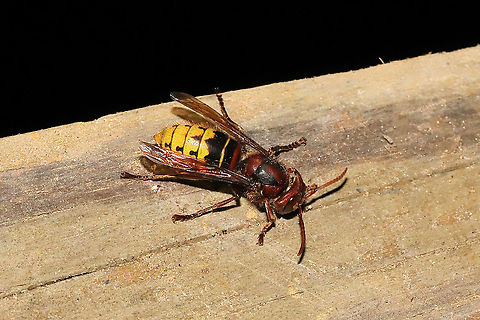
Appearance
The eyes of "V. crabro" are deeply indented and shaped like a "C". Its wings are reddish-orange, while the petiolate abdomen is striped with brown and yellow. It has hair on the thorax and abdomen, although the European hornet is not as hairy as most bees. Due to this coloration and abdomen pattern, "V. crabro" is often mistaken for the Asian giant hornet. Typical mass size for the European Hornet is 477.5±59.9 mg. Workers average around 25 mm in length, while the larger queens can reach up to 35 mm. This is significantly larger than most common wasps, but smaller than the Asian giant hornet. Females are typically larger than males in both size and mass. However, male abdomens have seven segments, whereas female abdomens have six. There is a cerebral ganglion, two thoracic ganglia, and five abdominal ganglia. Only females possess a stinger, it is a modified egg laying device : males cannot sting. The antennae of males are slightly longer, with 13 segments compared to twelve segments in females.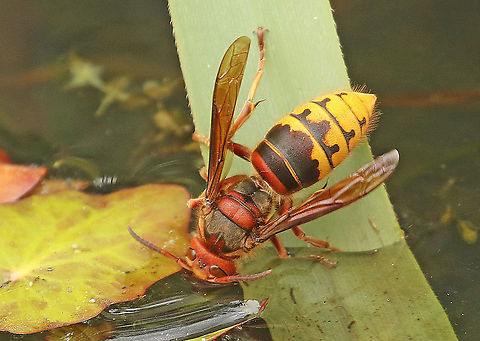
Naming
Unwarranted fear of "V. crabro" has often led to the destruction of nests. This has led to the decline of the species, which is often locally threatened or even endangered. European hornets benefit from legal protection in some countries, notably Germany, where killing a European hornet or nest has been illegal since January 1, 1987, with a fine up to €50,000. However, the highest reported fine levied in Germany for killing of wasps was €45, and experts report that fines are rarely imposed.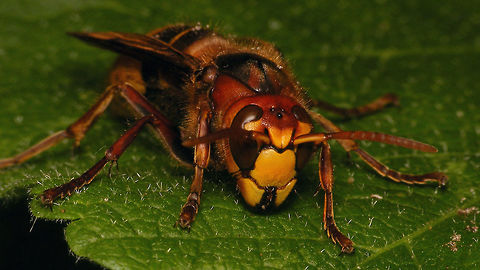
Distribution
The European hornet "V. crabro" originated in Eurasia. Nests historically ranged from Japan to the United Kingdom. However, Saussure reported that "V. crabro" was introduced to North America in the mid-19th century, where it is now well established. In 2010, they were found as far south as Guatemala. The few nests in Guatemala were thought to be recent, accidental introductions, as they were the first to be documented.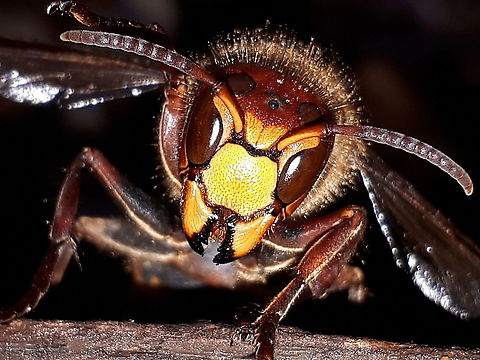
Status
Unwarranted fear of "V. crabro" has often led to the destruction of nests. This has led to the decline of the species, which is often locally threatened or even endangered. European hornets benefit from legal protection in some countries, notably Germany, where killing a European hornet or nest has been illegal since January 1, 1987, with a fine up to €50,000. However, the highest reported fine levied in Germany for killing of wasps was €45, and experts report that fines are rarely imposed.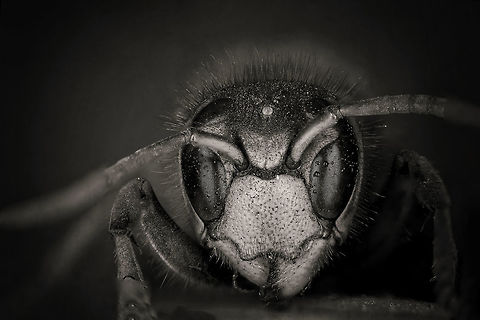
Behavior
"V. crabro" prefers to build nests in dark places, usually hollow tree trunks. After the site has been chosen, the queen lays eggs in the combs inside the nest. The workers dispose of any eggs that are not laid by their queen; this behavior is called worker policing. Based on laboratory data, the average rate of egg-laying is 2.31 eggs per day. However, in this same nest, cell construction rate was only 1.63 cells per day."V. crabro" colonies seasonally change strategies of obtaining food for both the larvae and adults. In April, when the queen normally lays her eggs, the workers actively go out and forage. Later, typically around the fall season, the foraging workers switch to scavengers. Instead of putting forth the effort to catch food sources, the workers try to take what is more easily available. For example, European hornets have been seen hovering around garbage cans and picnic areas in the fall.Social hymenopteran species typically communicate with each other through behaviors or pheromones. In the European hornet, a typical alarm dance is performed outside of the nest and consists of consistent buzzing, darting in and out of the nest, and attacking or approaching the target of the alarm pheromone. The alarm pheromone is stored in, and secreted from, internal venom sacs. 2-Methyl-3-butene-2-ol is the main pheromone component that causes "V. crabro" to express this defensive behavior. Other pentenols and pentanols are contained within these venomous sacs, but their primary purpose is likely not to warn fellow hornets that danger is nearby, because these chemicals do not induce alarm behavior.
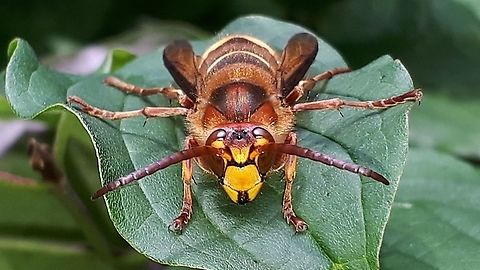
Reproduction
Individuals typically live in paper nests, which consist of a pedicle, an envelope, and a single entry hole on the outside. Materials such as twigs, branches, and other available plant resources are broken up, chewed, and shaped into a nest by the workers. These pieces are not uniform in shape, but are glued together very closely. Because social wasps generally prefer to build nests in the dark, envelopes are commonly found surrounding the nests to make them dark if the colony could not locate a dark crevice in which to build. The rove beetle "Velleius dilatatus" is commensal with the European hornet, living much of its life in the detritus of the nest.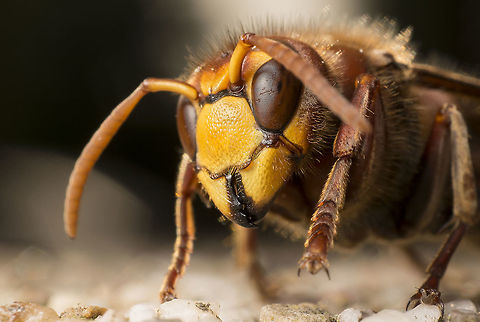
Defense
Most cases of stings from "V. crabro" do not require medical attention, but rarely can be serious. A documented case requiring treatment displayed symptoms including tingling at the site of the sting, headaches, and shortness of breath. In the hospital, the victim was found to have a fast, irregular heartbeat with a blood pressure of 111/63. A subsequent EKG demonstrated atrial fibrillation with a rapid ventricular response. "V. crabro" venom contains neurotransmitters such as dopamine, serotonin, histamine and noradrenalineneurotoxin apamin, as well as enzymes phospholipase A and hyaluronidase, and proteins melittin and bradykinin. These compounds have been shown to cause episodes of tachycardia in smaller animals. The mechanism of the described attack is still undetermined, but the victim was possibly abnormally susceptible to vespine stings. Currently, the two most effective treatments for reactions are electrical cardioversion or propafenone. The victim in this case study was given an oral dose of propafenone and his atrial fibrillation resolved.References:
Some text fragments are auto parsed from Wikipedia.